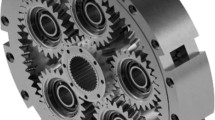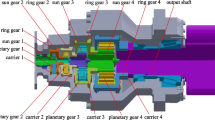Abstract
Planetary gearsets are widely used in several mechanical systems and have numerous advantages over counter-shaft gears. Despite this, the complex arrangement of components in a planetary gear system makes them susceptible to noise and vibration issues. An exhaustive and rich literature is available on the topic of planetary gear dynamics, but most of these studies consider only the parametric excitation of gear mesh contacts while assuming an ideal power source. But contrary to this popular assumption, realistic power sources (IC Engine, electric motor, wind turbine, etc.) could be subjected to torque fluctuations based on the operating conditions. The current study presents a theoretical investigation on the load distribution and dynamic behavior of planetary gear sets subjected to both internal and external excitations. A three-dimensional dynamic planetary load distribution model that inherently captures the internal excitation due to the elastic gear mesh contacts is employed in this study. The influence of operating conditions on both system-level response and local gear mesh contact stress distribution are explored. Discussed results not only illustrate the potential of the dynamic model but also reinforce the need for such computationally efficient models for design and analysis purposes.
Zusammenfassung
Planetengetriebe sind in mehreren mechanischen Systemen weit verbreitet und haben zahlreiche Vorteile gegenüber Gegenwellengetrieben. Trotzdem macht die komplexe Anordnung von Komponenten in einem Planetengetriebe sie anfällig für Lärm- und Vibrationsprobleme. Eine erschöpfende und reichhaltige Literatur ist zum Thema der planetendynamischen Gangdynamik verfügbar, aber die meisten dieser Studien betrachten nur die parametrische Anregung von Zahnradnetzkontakten, während sie eine ideale Kraftquelle annehmen. Entgegen dieser gängigen Annahme könnten jedoch realistische Energiequellen (IC-Motor, Elektromotor, Windkraftanlage usw.) Drehmomentschwankungen auf der Grundlage der Betriebsbedingungen ausgesetzt werden. Die aktuelle Studie präsentiert eine theoretische Untersuchung über die Lastverteilung und das dynamische Verhalten von Planetengetriebesätzen, die sowohl internen als auch externen Anregungen ausgesetzt sind. In dieser Studie wird ein dreidimensionales dynamisches Planetenlastverteilungsmodell verwendet, das die interne Anregung durch die elastischen Zahnnetzkontakte inhärent erfasst. Der Einfluss der Betriebsbedingungen auf die Reaktion auf Systemebene und die Verteilung der Kontaktspannungsverteilung im lokalen Zahnnetznetz wird untersucht. Die diskutierten Ergebnisse veranschaulichen nicht nur das Potenzial des dynamischen Modells, sondern verstärken auch die Notwendigkeit solcher recheneffizienten Modelle für Entwurfs- und Analysezwecke.












Similar content being viewed by others
References
Bodas A, Kahraman A (2004) Influence of carrier and gear manufacturing errors on the static load sharing behavior of planetary gear sets. JSME Int J C Mech Syst Mach Elem Manuf 47(3):908–915
Singh A (2005) Application of a system level model to study the planetary load sharing behavior. J Mech Des 127(3):469–476
Kahraman A (1994) Load sharing characteristics of planetary transmissions. Mech Mach Theory 29(8):1151–1165
Cooley CG, Parker RG (2014) A review of planetary and epicyclic gear dynamics and vibrations research. Appl Mech Rev 66(4):40804
Nigam A, Sandeep J (2015) Modelling and structural analysis of planetary geared winch. Int J Sci Res 4(1):330–333
Stoyanov S, Dobrev V, Dobreva A (2017) Finite elements contact modelling of planetary gear trains. IOP Conf Ser Mater Sci Eng 252:12034
Zeng Q, Jiang S, Wan L, Li X (2015) Finite element modeling and analysis of planetary gear transmission based on transient meshing properties. Int J Model Simul Sci Comput 6(03):1550035
Kahraman A, Vijayakar S (2001) Effect of internal gear flexibility on the quasi-static behavior of a planetary gear set. J Mech Des Trans ASME 123(3):408–415
Abousleiman V, Velex P (2006) A hybrid 3D finite element/lumped parameter model for quasi-static and dynamic analyses of planetary/epicyclic gear sets. Mech Mach Theory 41(6):725–748
Abousleiman V, Velex P, Becquerelle S (2007) Modeling of spur and helical gear planetary drives with flexible ring gears and planet carriers. J Mech Des 129(1):95–106
Do TP, Ziegler P, Eberhard P (2013) Simulation of elastic gears with non-standard flank profiles. Arch Mech Eng 60(1):55–73
Inalpolat M, Kahraman A (2008) Dynamic modelling of planetary gears of automatic transmissions. Proc Inst Mech Eng Part K J Multi-body Dyn 222(3):229–242
Velex P, Ajmi M (2006) On the modelling of excitations in geared systems by transmission errors. J Sound Vib 290(3):882–909
Kahraman A (1994) Planetary gear train dynamics. J Mech Des 116(3):713–720
Velex P, Flamand L (1996) Dynamic response of planetary trains to mesh parametric excitations. J Mech Des Trans ASME 118(1):7–14
Lin J, Parker RG (2002) Planetart gear parametric instability caused by mesh stiffness variation. J Sound Vib 249(1):129–145
Ambarisha VK, Parker RG (2005) Suppression of planet mode response in planetary gear dynamics through mesh phasing. J Vib Acoust 128(2):133–142
Ambarisha VK, Parker RG (2007) Nonlinear dynamics of planetary gears using analytical and finite element models. J Sound Vib 302(3):577–595
Al-Shyyab A, Kahraman A (2007) A non-linear dynamic model for planetary gear sets. Proc Inst Mech Eng Part K J Multi-body Dyn 221(4):567–576
Inalpolat M, Kahraman A (2010) A dynamic model to predict modulation sidebands of a planetary gear set having manufacturing errors. J Sound Vib 329(4):371–393
Ryali L, Talbot D (2021) A dynamic load distribution model of planetary gear sets. Mech Mach Theory 158:104229
Hu Y, Talbot D, Kahraman A (2018) A load distribution model for planetary gear sets. J Mech Des 140(5):53302
Li Y, Chen T, Wang X (2014) Non-linear dynamics of gear pair with dynamic backlash subjected to combined internal and external periodic excitations. J Vib Control 22(6):1693–1703
Fang Y, Zuo MJ, Li Y (2019) Investigation of gear dynamic characteristics under stochastic external excitations. IOP Conf Ser Mater Sci Eng 576:12013
Bai W, Qin D, Wang Y, Lim TC (2018) Dynamic characteristics of motor-gear system under load saltations and voltage transients. Mech Syst Signal Process 100:1–16
Zhao M, Ji J (2016) Dynamic analysis of wind turbine gearbox components. Energies 9(2):110
Zhao M, Ji JC (2015) Nonlinear torsional vibrations of a wind turbine gearbox. Appl Math Model 39(16):4928–4950
Li C, Zhou Y, Lim TC, Sun G (2016) Dynamic responses of a wind turbine drivetrain under turbulent wind and voltage disturbance conditions. Adv Mech Eng 8(5):1687814016649936
Bati A, Luk PCK (2015) Analysis of drive-train resonance and torque ripple smoothing of a 50 kW vertical axis wind turbine. In: 2015 IEEE International Conference on Industrial Technology (ICIT), pp 1263–1268
Guo Y, Keller J, Parker RG (2012) Dynamic analysis of wind turbine planetary gears using an extended harmonic balance approach: preprint. https://www.nrel.gov/docs/fy12osti/55355.pdf
Ligata H, Kahraman A, Singh A (2009) A closed-form planet load sharing formulation for planetary gear sets using a translational analogy. J Mech Des 131(2):21007
Ryali L, Verma A, Hong I, Talbot D, Zhu F (2021) Experimental and theoretical investigation of quasi-static system level behavior of planetary gear sets. J Mech Des. https://doi.org/10.1115/1.4050302
Chen Q, Xu G, Liu G, Zhao W, Liu L, Lin Z (2018) Torque ripple reduction in five-phase IPM motors by lowering interactional MMF. IEEE Trans Ind Electron 65(11):8520–8531
Hwang M‑H, Lee H‑S, Cha H‑R (2018) Analysis of torque ripple and cogging torque reduction in electric vehicle traction platform applying rotor notched design. Energies 11(11):3053
Wang K, Zhu ZQ, Ombach G, Koch M, Zhang S, Xu J (2015) Torque ripple reduction of synchronous reluctance machines: using asymmetric flux-barrier. COMPEL 34(1):18–31
Hu Y, Ryali L, Talbot D, Kahraman A (2019) A theoretical study of the overall transmission error in planetary gear sets. Proc Inst Mech Eng Part C J Mech Eng Sci 233(21/22):7200–7211
Vijayakar SM, Houser DR (1988) Use of boundary elements for the determination of the AGMA geometry factor. Gear Technol 5(1):7–9, 33
Author information
Authors and Affiliations
Corresponding author
Ethics declarations
Conflict of interest
L. Ryali and D. Talbot declare that they have no competing interests.
Rights and permissions
About this article
Cite this article
Ryali, L., Talbot, D. Dynamic load distribution of planetary gear sets subject to both internal and external excitations. Forsch Ingenieurwes 86, 283–294 (2022). https://doi.org/10.1007/s10010-021-00506-6
Received:
Accepted:
Published:
Issue Date:
DOI: https://doi.org/10.1007/s10010-021-00506-6




